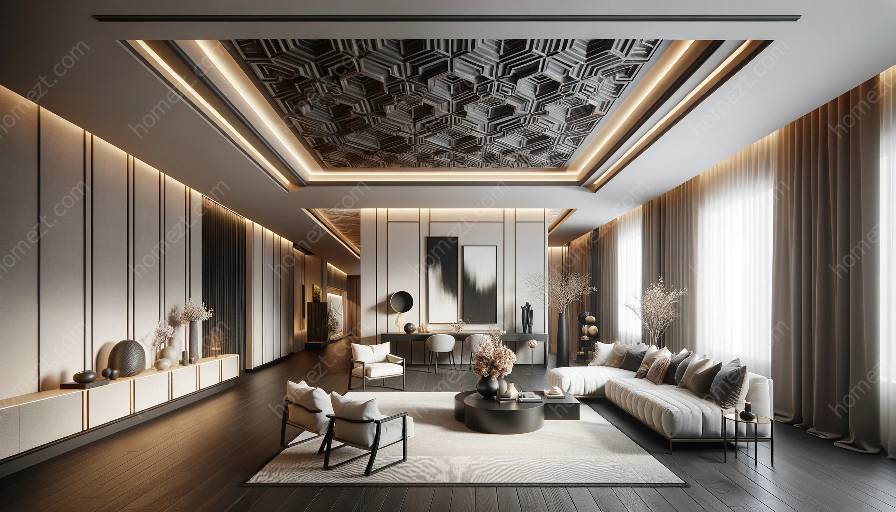When it comes to interior design, creating a statement ceiling can completely transform the look and feel of a space. From intricate designs to bold colors, a statement ceiling can add depth and character to any room. However, it's important to consider acoustics when designing a statement ceiling to ensure that the space remains functional and comfortable.
Understanding Acoustics
Before diving into the design process, it's essential to have a basic understanding of acoustics and how sound behaves within a given space. Acoustic design is a crucial aspect of interior design, especially in areas where noise control and sound quality are important considerations. Sound waves can bounce off hard surfaces such as ceilings, resulting in reverberation and echoing. Moreover, a poorly designed ceiling can lead to poor speech intelligibility and an overall unpleasant auditory experience.
When planning a statement ceiling, it's necessary to explore ways to mitigate these acoustic challenges without compromising the visual impact of the design. This involves selecting materials, textures, and shapes that can help absorb, diffuse, or block sound waves, contributing to a more pleasant acoustic environment.
Choosing Acoustic-Friendly Materials
One of the first steps in designing a statement ceiling with acoustics in mind is to select materials that offer sound-absorbing properties. Acoustic ceiling panels, made from materials like fabric, fiberglass, or foam, are popular choices for controlling sound reflections while providing a decorative element. These panels come in a variety of colors and textures, allowing for creative customization to complement the overall design aesthetic.
Additionally, utilizing perforated metal or wood ceiling tiles can improve acoustics by allowing sound to pass through and be absorbed by underlying materials. These tiles can be installed in a variety of patterns and configurations, offering both functional and visually appealing solutions for statement ceilings.
Considering the Room Function
During the design process, it's crucial to consider the specific function of the room where the statement ceiling will be implemented. For instance, a statement ceiling in a home theater will have different acoustic requirements compared to one in a restaurant or office space. Understanding the purpose of the room will guide the selection of acoustically appropriate materials and design elements.
For spaces where speech intelligibility and minimal background noise are essential, such as conference rooms or lecture halls, the focus should be on implementing sound-absorbing materials to minimize reverberation and enhance clarity. On the other hand, in spaces where music or ambient sound is desirable, diffusive materials and designs can enhance the overall acoustic experience while still making a visual impact.
Enhancing Visual Impact
Despite the emphasis on acoustic considerations, designing a statement ceiling also involves maximizing visual impact. The selection of colors, patterns, and lighting can contribute to creating an aesthetically pleasing and attention-grabbing design. Incorporating bold colors or intricate patterns in the ceiling design can enhance the overall ambiance of the space, helping to establish a unique and memorable environment.
Furthermore, incorporating statement lighting fixtures, such as pendant lights or recessed lighting, can draw attention to the ceiling and accentuate its design. Well-placed lighting can highlight architectural details and create visual interest, transforming the ceiling into a focal point within the room.
Maintaining Design Cohesion
When integrating a statement ceiling into an existing interior design scheme, it's important to ensure that the new design harmonizes with the overall aesthetic of the space. The statement ceiling should complement the existing decor and architectural elements, creating a cohesive and integrated look. This can be achieved through careful consideration of color palettes, design motifs, and material finishes.
Additionally, incorporating decorative elements, such as ceiling moldings, trims, or custom murals, can add depth and texture to the statement ceiling, further enhancing its visual appeal while contributing to the overall design language of the space.
Decorating the Statement Ceiling
Once the foundational elements of the statement ceiling are in place, decorating and styling the ceiling can add the finishing touches to the design. This may involve adding artistic details, such as hand-painted designs, stencils, or murals, to create a bespoke and personalized look. Moreover, incorporating other decorative elements, such as hanging plants, fabric drapery, or suspended sculptures, can infuse creativity and originality into the design.
In terms of functionality, the integration of sound-absorbing materials should not limit the creative potential for decorating the statement ceiling. By carefully selecting decorative elements that also serve acoustical purposes, such as fabric-wrapped acoustic panels or perforated screens, designers can achieve a seamless balance between aesthetics and functionality.
Conclusion
Designing a statement ceiling that incorporates acoustic considerations is a multi-faceted task that requires a thoughtful balance between aesthetic appeal and functional performance. By understanding the principles of acoustics and selecting appropriate materials, designers can create a visually stunning ceiling while ensuring an optimal auditory experience. Ultimately, a well-designed statement ceiling not only enhances the overall ambiance of a space but also contributes to its comfort and functionality.






































